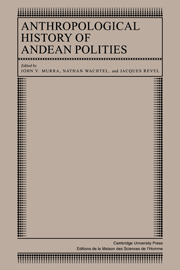Book contents
Introduction
Published online by Cambridge University Press: 05 October 2010
Summary
In an environment of violent contrasts, frequently at the very limits of adaptive possibilities, Andean America is truly a testing ground for human and social disciplines. The societies developed here, numerous and extremely diverse, lived in isolation from the rest of the world for thousands of years, achieving most of what they did on their own. Their history followed an original, pristine course. The culmination of these processes is the emergence of Tawantinsuyu, the Inka state, one of the larger and more powerful preindustrial polities.
If such independent development were to be appreciated for the rare opportunity it provides for comparative inquiry, one could expect Andean studies to flourish. This dimension is not yet the dominant one. Nonetheless, independent of any comparative urge, our understanding of the Andean world has undergone some major changes during the last few decades, a progress not only quantitative, through an accumulation of discoveries, but also qualitative, through changes in the sources used, our methods, and the very object of our inquiry. How do we explain this mutation?
For centuries, historians, both from the Andean republics and from abroad, had centered their fascinated attention on the Inka “empire.” Ever since the sixteenth century, Andean precious metals had fed fantasies of El Dorados; Andean institutions also provided “facts” for the Utopian needs of writers as diverse as the Inca Garcilaso de la Vega and Marmontel. As recently as 1928, the carefully documented work of Louis Baudin was entitled L'Empire socialiste des Inkas.
- Type
- Chapter
- Information
- Anthropological History of Andean Polities , pp. 1 - 8Publisher: Cambridge University PressPrint publication year: 1986
- 17
- Cited by



